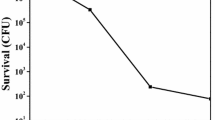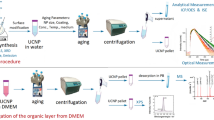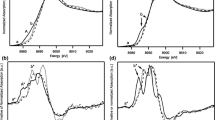Abstract
The biological effects of rare-earth ions on the organism have been studied using Pr3+ as a probe ion and Escherichia coli cell as a target. Atomic force microscopy (AFM) observation of the surface of E. coli cells shows that the presence of Pr3+ substantially changes the structure of the outer membrane. By induced coupled plasma-mass spectrometry (ICP-MS), more Cu2+ was found in the cells grown in the presence of Pr3+, indicating changes of cell permeability. Using energy dispersive X-ray spectroscopy (EDX), Ca2+ is found on the outer surface of the original cell. It is proposed that Pr3+ can replace Ca2+ from the binding sites because of their close ionic radii and similar ligand speciality.




Similar content being viewed by others
References
Chunying Chen, Peiqun Zhang, Zhifang Chai (2001) Distribution of some rare earth elements and their binding species with proteins in human liver studied by instrumental neutron activation analysis combined with biochemical techniques. Anal Chim Acta 439:19–27
Calabrese EJ (2005) The rebirth of hormesis as a central pillar of toxicology. Toxicology and Applied Pharmacology 204:1–8
Zhao RM, Liu Y, Shen P, Qu SS (2000) Inhibition and stimulating effect of Er3+ and its cationic monoporphyrinate complex on growth of Staphylococcus aureus. J Biochem Biophys Methods 46:1–9
Hu X, Ding ZH, Chen YJ (2002) Bioaccumulation of lanthanum and cerium and their effects on the growth of wheat (Triticum aestivum L.) seedlings[J]. Chemosphere 48:621–629
Xu XK, Zhu WZ, Wang ZJ (2002) Distribution of rare earths and heavy metals in field grown maize after application of rare earth-containing fertilizer [J]. Sci Total Environ 293:97–105
Boquan J, Zhiqiang Y, Jian P (2006) Study on physical and chemical behaviors of rare earths in preparing ceramic tube supported palladium film by electroless plating. J Rare Earths 24:259–262
Tian J-Y, Lu J-S, Mu L-L, Du B-X (2006) Study on the performance and preparation of Ce_(0.6)Zr_(0.35)Pr_(0.05)O_2 Nano Solid Solution. J Mater Sci Eng 24:730–732
Evangelou MWH, Bauer U, Ebel M, Schaeffer A (2007) The influence of EDDS and EDTA on the uptake of heavy metals of Cd and Cu from soil with tobacco Nicotiana tabacum. Chemosphere 68:345–353
Andrews AT, Pallavicini C (1973) Bovine milk acid phosphatase. I. Some kinetics studies and other properties using a partially purified preparation. Biochim Biophys Acta Enzymol 321:197–209
Peng L, Yi L, Ping S (2004) Study on biological effect of La3+ on Escherichia coli by atomic force microscopy. J Inorg Biochem 98:68–72
Butt HJ, Wolff EK, Gould SAC, Dixon Northern B, Peterson CM, Hansma PK (1990) Imaging cells with the atomic force microscope. J Struct Biol 105:54–61
Qi H, Liu Y, Zhuang L-N, Zhu J, Sun R-G (2007) The research on best imaging condition of the AFM on Cells. Acta Photonica Sinica 36(1):138–143
Amro NA, Kotra LP, Wadu-Mesthrige K, Bulychev A, Mobashery S, Liu G-Y (2000) High-resolution atomic force microscopy studies of the Escherichia coli outer membrane: structural basis for permeability. Langmuir 16:2789–2796
Lakshmi P Kotra, Dasantila Golemi, Nabil A Amro, Gang-Yu Liu, Shahriar Mobashery (1999) Dynamics of the Lipopolysaccharide assembly on the surface of Escherichia coli. J Am Chem Soc 121:8707–8711
Yang P (1991) Introduction of bioinorganic chemistry. Xi’an Jiaotong University Press, China, pp 281–182
Yi XW, Huang CH (1998) Rare-earth element. Science Press, Beijing, pp 179–187
Rashkovich LN (2004) Atomic force microscopy of growth and dissolution of calcium oxalate monohydrate (COM) crystals. Cryst Growth 261:539–548
Touryan Michael J, Lochhead MJ, Marquardt BJ, Vogel V (2004) Sequential switch of biomineral crystal morphology using trivalent ions. Nature Materials 3:239–243
Schouw NL1, Danteravanich S, Mosbaek H, Tjell JC (2002) Composition of human excreta: a case study from Southern Thailand. Sci Total Environ 286:155–166
Chang LC, Lin HS, Chen WC (2001) The reappraisal of nephrocalcin: its role in the inhibition of calcium oxalate growth and interaction with divalent metal ions [J]. Urol Res 29:89–93
Acknowledgement
We gratefully acknowledge the financial support of National Natural Science Foundation of China (30570015, 20373051), “973” Project (2004CB719603), Science Fund for Creative Research Group (No.20621502 NSFC), Science Research Foundation of Chinese Ministry of Education (NO: [2006]8IRT0543), Natural Science Foundation of Hubei Province (No.2005ABC02), and Open fund of State Key Laboratory of Advanced Technology for Materials Synthesis and Processing (Wuhan University of Technology, WUT2006M01).
Author information
Authors and Affiliations
Corresponding author
Rights and permissions
About this article
Cite this article
Peng, L., Weiying, Z., Xi, L. et al. Structural Basis for the Biological Effects of Pr(III) Ions: Alteration of Cell Membrane Permeability. Biol Trace Elem Res 120, 141–147 (2007). https://doi.org/10.1007/s12011-007-8015-5
Received:
Revised:
Accepted:
Published:
Issue Date:
DOI: https://doi.org/10.1007/s12011-007-8015-5




